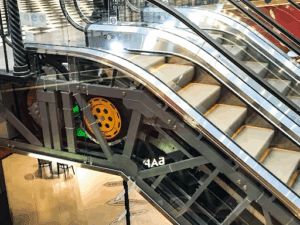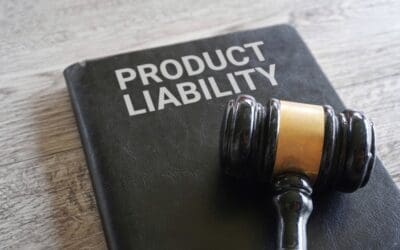Each year in the United States, more than 10,000 people visit emergency departments due to escalator injuries. About half of these injuries involve falls, and about one in five involve entrapment or mechanical problems. These figures are derived from the Consumer Product Safety Commission’s NEISS data and a 2013 study published in the American Journal of Emergency Medicine. Florida experiences high escalator usage in malls, airports, hotels, and theme parks, which increases exposure to these risks, according to CPSC NEISS data.
These facts create escalator slip and fall legal challenges in Florida that are more complex than a typical premises case. More than one party can be responsible. Property owners, managers, maintenance companies, and manufacturers may all share liability depending on inspection logs, repair records, and code compliance. Florida uses a modified comparative negligence system. If you are found more than 50% at fault for an accident that happened on or after March 24, 2023, you may be barred from recovering damages.
The ASME A17.1 safety code and the Florida Building Code set standards for handrail speed, step markings, emergency stops, and routine maintenance. Proving a case often requires quick evidence preservation, expert inspections, and a focus on who failed to meet these standards. Successfully handling these escalator slip and fall legal challenges in Florida starts with a prompt and thorough investigation.

Key Takeaways
- Multiple parties, including property owners, manufacturers, and contractors, may share liability, complicating the determination of responsibility in escalator slip and fall cases.
- Florida’s comparative fault system assigns liability percentages based on each party’s degree of contribution to the accident, which in turn affects the compensation amounts.
- Proving negligence requires demonstrating breach of duty through inadequate maintenance, failed inspections, or violation of safety regulations.
- Strict liability standards apply to manufacturers for defective equipment without requiring proof of negligence, only design or manufacturing defects.
- Complex insurance negotiations involve multiple policies with varying coverage limits, exclusions, and overlapping responsibilities across liable parties.
5 Escalator Slip And Fall Legal Challenges In Florida
- Identifying every liable party – Property owners, managers, maintenance contractors, manufacturers, and installers may each share some degree of fault. Sorting out contracts, service agreements, and control of the escalator helps assign responsibility.
- Preserving critical technical evidence – Surveillance video, maintenance logs, inspection reports, and parts can disappear quickly. Immediate preservation letters and expert inspections are essential to prove what failed and why.
- Proving code and standards violations – Claims often hinge on ASME A17.1 requirements, Florida Building Code provisions, and Bureau of Elevator Safety rules. You need expert testing for handrail and step speed, step demarcation, skirt clearance, and emergency stop access.
- Overcoming comparative fault arguments – Defendants may argue that the rider’s conduct contributed to the fall. You must document conditions, signage, crowding, and housekeeping to minimize any fault assigned to you under Florida’s modified comparative negligence law.
- Coordinating multiple insurance policies and limits – Different defendants have separate insurers with exclusions and overlapping coverages. Strategic claims handling and negotiation are needed to access all available limits and maximize recovery.
Common Causes of Escalator Accidents in Tampa
 1. Mechanical Failures and Defective Components
1. Mechanical Failures and Defective Components
Escalator accidents in Tampa often begin with worn or broken parts that go unnoticed. Damaged steps, misaligned treads, and loose skirting can cause sudden trips and falls, posing a significant safety risk. Defective handrails that slow, stop, or move at a different speed than the steps lead to loss of balance. Comb plates that are cracked or set too low can catch shoes, clothing, or mobility aids, potentially leading to serious injuries and escalator slip and fall legal challenges in Florida.
Routine wear becomes dangerous when parts are not replaced on schedule. Heat, humidity, and heavy tourist traffic in Tampa’s malls and transit hubs accelerate component fatigue. Failures in braking systems or step chains can cause abrupt stops that throw riders forward. These events often require engineering inspections to identify the fault and determine the cause, thereby strengthening claims involving escalator slip-and-fall legal challenges in Florida.
2. Inadequate Maintenance and Inspection Practices
Poor maintenance protocols allow minor defects to turn into significant hazards. Skipped daily checks, incomplete lubrication schedules, and ignored vibration or noise warnings are common problems. Missing documentation makes it hard to prove compliance with manufacturer recommendations and safety codes. When logs are incomplete, it becomes easier to show a pattern of neglect that supports escalator slip and fall legal challenges in Florida.
Tampa properties with high foot traffic need frequent inspections to keep pace with usage. Mall operators and building managers should track issues like handrail tension, step demarcation paint, and emergency stop function. Third-party maintenance contractors must adhere to clear service intervals and maintain detailed records. When they do not, liability can extend to both the owner and the maintenance company.
3. Slippery Surfaces and Housekeeping Failures
Spilled drinks, rainwater tracked in from parking areas, and cleaning overspray create slick steps and landings. Inadequate matting at entrances and poor drainage near escalator approaches raise the slip risk. Lack of prompt cleanup and warning cones can turn a minor spill into a serious fall. These housekeeping lapses are common in food courts, stadiums, and retail establishments adjacent to transit.
Escalator steps have grooves meant to channel liquids, but they are not a substitute for timely cleanup. Detergent residue from cleaning can leave a thin film that reduces traction. Metal steps and rubber-soled shoes can become especially slippery in humid conditions. Video surveillance, incident reports, and cleaning schedules often provide crucial evidence about notice and response times.
4. Installation Errors and Code Noncompliance
Improper installation can introduce defects into the system from the outset. Misaligned comb plates, incorrect step-to-skirt clearances, or handrail speed mismatches violate safety standards. Missing or faded step edge markings can reduce depth perception and increase the likelihood of missteps. These conditions are preventable when contractors follow the manufacturer’s specifications and applicable codes and regulations.
Tampa property owners must ensure that new or modernized escalators pass required inspections. Post-installation testing should verify emergency stop access, step lighting, and handrail synchronization. If commissioning reports are incomplete or ignored, dangerous conditions can persist for years. Liability may include installers, property owners, and any consultants who signed off on noncompliant work.
5. Negligent Supervision and Crowd Management
High-traffic events can overwhelm escalators when crowd flow is not controlled. Overloading, rushing, and blocked landings increase the chance of falls and entanglements. A lack of attendants or clear signage can allow unsafe behavior to go unchecked. Proper supervision helps keep riders spaced, landings clear, and children assisted.
Property managers should coordinate security and housekeeping during peak hours to ensure a seamless experience for residents. Stanchions and floor markings can manage queues and prevent pileups at entry and exit points. Staff should be trained to stop an escalator promptly when hazards are detected. Incident readiness and clear procedures reduce both injuries and legal exposure for businesses in Tampa.
Understanding Liability in Escalator Slip and Fall Cases

If you were hurt on an escalator, several parties may be responsible for your injuries, including the property owner, the manager, the maintenance contractor, and the manufacturer. Industry data show that U.S. escalators handle roughly 105 billion passenger rides each year, and an estimated 6,000 to 10,000 emergency department visits are tied to escalator injuries. This is why identifying every responsible party is crucial.
Under Florida premises law, property owners are required to inspect and correct hazards within a reasonable timeframe, and manufacturers may be held liable for defective parts or inadequate warnings. In Tampa’s busiest spots, like malls and airports, a single escalator can serve more than 5,000 riders on a peak day, so inspection frequency and accurate records are critical to your case.
To win, you need to prove duty, breach, causation, and damages using evidence such as maintenance logs, commissioning reports, and surveillance video. Insurance reviews reveal that many escalator claims involve missing or incomplete maintenance documentation, and audits frequently identify issues such as handrail and step speeds that do not match or emergency stop buttons that are obstructed. Florida’s comparative fault rules let juries divide blame among everyone involved, which directly affects your recovery in escalator slip and fall legal challenges in Florida.
Florida’s Escalator Safety Regulations and Compliance Requirements
Florida’s Bureau of Elevator Safety sets and enforces rules that shape your escalator accident claim by defining clear safety standards and compliance duties. Certified elevator inspectors are required to perform annual inspections to identify defects and code violations. Property owners must keep a valid Certificate of Operation, perform routine maintenance, and comply with ASME A17.1 safety codes adopted in Florida. These requirements create a paper trail that can show exactly where safety broke down.
If owners or contractors fail to attend inspections, skip maintenance, or disregard repair notices, their legal liability increases. Florida has also implemented accountability measures, including an August 1, 2025, deadline for installing door lock monitoring systems on applicable equipment. Tampa highlights safety each year during Elevator Escalator Safety Awareness Week to reduce injuries and educate the public about personal injury law misconceptions. Knowing how these rules work helps you prove fault in escalator slip and fall legal challenges in Florida and supports your claim for fair compensation.
The Role of Property Owners in Escalator Maintenance
Property owners bear primary responsibility for escalator safety through thorough maintenance obligations that directly affect your accident case’s outcome. When a slip and fall incident occurs on commercial properties, property owner liability hinges on their adherence to established maintenance best practices and escalator inspection protocols.
| Property Owner Duties | Legal Implications |
|---|---|
| Daily visual inspections | Demonstrates due diligence |
| Monthly professional maintenance | Reduces negligence claims |
| Annual safety compliance audits | Guarantees regulatory adherence |
| Immediate hazard response | Minimizes liability exposure |
The strength of your case depends on whether the owners implemented proper accident prevention strategies. Florida law requires owners to maintain current certifications, conduct regular safety compliance audits, and promptly address mechanical issues. Documentation gaps in maintenance records often become pivotal evidence in slip and fall claims, establishing the negligence that supports your compensation case.
Manufacturer and Contractor Responsibility for Defective Equipment
Escalator manufacturers and contractors can be held liable for injuries caused by faulty parts or substandard work. In many product cases, you do not have to prove negligence. You only need to show that the escalator was defectively designed, defectively made, or lacked proper warnings. This is important in escalator slip and fall legal challenges in Florida because it simplifies the process of proving fault against the manufacturer.
Contractors who install or service escalators must comply with Florida’s safety regulations and the ASME A17.1-2019 code. Contractor negligence encompasses poor installation, missed maintenance, or failure to comply with code or permit requirements. These companies carry specialized insurance because they know the risks. Your lawyer can bring claims against the manufacturer, the installer, and the maintenance company simultaneously to maximize recovery in escalator slip and fall legal challenges in Florida.
Critical Evidence Needed to Prove Your Escalator Accident Case

To prove your claim, you need clear, timely evidence that ties unsafe conditions to your injuries. Start collecting evidence right away. Take photos and videos of the scene, including the steps, handrails, comb plates, and any spills or warning signs. Save your shoes and clothing if they were caught or damaged, as they may be relevant in escalator slip and fall legal challenges in Florida.
Obtain contact information for witnesses and request short written or recorded statements while the details are still fresh. Request security footage from the property manager immediately and send a preservation letter to prevent the footage from being deleted. Gather maintenance and inspection records, service logs, work orders, and any code violation notices. These documents reveal what the owner and contractor knew and when they became aware of it, which is crucial in escalator slip-and-fall legal challenges in Florida.
Types of Injuries Sustained in Escalator Falls
- Traumatic brain injuries, including concussions and intracranial hemorrhage
- Spinal cord injuries, herniated discs, and vertebral fractures
- Complex fractures of the wrist, ankle, hip, or pelvis
- Entrapment injuries causing deep lacerations, degloving, or amputations
- Crush injuries to feet and hands from comb plates and step edges
- Severe sprains, strains, and soft tissue tears to ligaments and tendons
- Nerve damage leading to numbness, weakness, or chronic pain
- Facial injuries such as orbital fractures, dental trauma, and jaw fractures
- Internal injuries, including organ contusions and internal bleeding
- Psychological injuries like post-traumatic stress, anxiety, and fear of riding escalators
- Secondary complications such as infections, deep vein thrombosis, or complex regional pain syndrome
These injury types are common in escalator slip and fall legal challenges in Florida and often require prompt diagnosis, careful documentation, and specialized treatment.
Navigating Insurance Claims After an Escalator Accident
After an escalator injury, you may deal with several insurance companies at the same time. The property owner usually has premises liability insurance. The maintenance company and the manufacturer often have their own policies too. Collect your medical records, incident report, photos, and any video as soon as you can. Ask each insurer for policy details and limits to determine the available coverage.
Watch the deadlines. For accidents on or after March 24, 2023, the general deadline to file a Florida negligence lawsuit is two years under Florida Statutes section 95.11 as amended by Chapter 2023-15, Laws of Florida.
Many policies also require quick notice. Be cautious with early settlement offers, as they may not fully cover future treatment or lost income. Hospital cost data from AHRQ’s HCUP shows serious injuries often cost far more than initial estimates. A personal injury lawyer can handle the insurers, protect your rights, and help you pursue full compensation in escalator slip and fall legal challenges in Florida.
Compensation Available for Escalator Accident Victims
 Escalator accident victims can pursue multiple categories of compensation that address both immediate and long-term consequences of their injuries. You’re entitled to recover medical expenses, including emergency treatment, surgeries, rehabilitation, and future healthcare needs. Lost wages and diminished earning capacity also qualify for compensation when injuries prevent you from working. Pain and suffering damages account for the physical discomfort and emotional trauma you’ve endured. The injury compensation process requires understanding complex liability laws and safety regulations.
Escalator accident victims can pursue multiple categories of compensation that address both immediate and long-term consequences of their injuries. You’re entitled to recover medical expenses, including emergency treatment, surgeries, rehabilitation, and future healthcare needs. Lost wages and diminished earning capacity also qualify for compensation when injuries prevent you from working. Pain and suffering damages account for the physical discomfort and emotional trauma you’ve endured. The injury compensation process requires understanding complex liability laws and safety regulations.
Legal representation benefits include steering insurance negotiations and maximizing settlement outcomes. Your attorney will access victim support resources while developing accident prevention strategies for future cases. Permanent disabilities may warrant additional compensation for adaptive equipment and lifestyle modifications. Understanding escalator safety tips helps strengthen your claim by demonstrating adherence to established standards of negligence.
Why You Need an Experienced Personal Injury Attorney
An experienced personal injury attorney helps you handle the complex parts of an escalator case from day one. These claims often involve multiple defendants, such as the property owner, the manager, the maintenance contractor, and the manufacturer, each with separate insurers.
A skilled attorney values your case fully by documenting medical treatment, future care, lost income, and pain and suffering, and by preparing for trial to pressure insurers to be fair. They track strict deadlines like Florida’s two-year statute of limitations for many negligence claims, keep your case on schedule, and usually work on contingency, so you pay no attorney’s fees unless they win. Reaching out early gives you the best chance at a strong recovery.
Conclusion: Winning Escalator Slip and Fall Legal Challenges in Florida
Escalator cases in Tampa rarely point to a single culprit. Careful investigation often shows that manufacturers, maintenance contractors, property owners, and even design professionals each played a role. Florida’s comparative fault rules make it essential to gather clear evidence that assigns responsibility to every party, from mechanical defects and missed inspections to safety code violations and design flaws. This is the only way to build leverage in escalator slip and fall legal challenges in Florida and protect the full value of your claim.
An experienced attorney can quickly secure records, coordinate expert inspections, and present a straightforward narrative that holds every defendant accountable. With the right team, you can pursue maximum compensation across all available insurance policies and resolve escalator slip and fall legal challenges in Florida with confidence.



